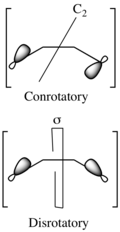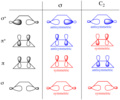Woodward–Hoffmann rules
Woodward–Hoffmann rules are a set of principles in organic chemistry and physical chemistry that predict the stereochemistry of the products of pericyclic reactions. These rules were formulated by Robert Burns Woodward, an American organic chemist, and Roald Hoffmann, an American theoretical chemist, in the early 1960s. The Woodward–Hoffmann rules are based on the conservation of orbital symmetry and provide a framework for understanding the behavior of electrons in a pericyclic reaction, which is a reaction that occurs in a single step, without intermediates, through a cyclic transition state.
Overview[edit]
Pericyclic reactions are characterized by the reorganization of electrons and bonds, typically involving π electrons, through a cyclic transition state. The Woodward–Hoffmann rules help predict whether a pericyclic reaction will proceed under thermal or photochemical conditions by analyzing the symmetry properties of the molecular orbitals involved. According to these rules, a pericyclic reaction can proceed in a suprafacial or antarafacial manner, depending on the conservation of orbital symmetry.
Rules[edit]
The Woodward–Hoffmann rules can be summarized as follows:
- For thermal reactions:
- Conrotatory motion is allowed for 4n π-electron systems in cycloaddition and electrocyclic reactions.
- Disrotatory motion is allowed for 4n+2 π-electron systems in electrocyclic reactions.
- For photochemical reactions:
- The allowed motions are reversed; disrotatory motion is allowed for 4n π-electron systems, and conrotatory motion is allowed for 4n+2 π-electron systems.
Applications[edit]
The Woodward–Hoffmann rules have wide applications in the synthesis of complex organic molecules. They are particularly useful in predicting the outcomes of Diels-Alder reactions, sigmatropic rearrangements, and other types of pericyclic reactions. Understanding these rules allows chemists to design synthetic pathways that lead to the desired stereochemistry of the product.
Significance[edit]
The development of the Woodward–Hoffmann rules was a significant milestone in the field of chemistry. It provided a theoretical foundation for understanding the behavior of electrons in pericyclic reactions, which was previously based on empirical observations. The rules have not only advanced the field of organic chemistry but also contributed to the development of new synthetic methods and materials. For their contributions, Woodward and Hoffmann were awarded the Nobel Prize in Chemistry in 1981.
See also[edit]
References[edit]
<references/>
-
Woodward–Hoffmann rules
-
Woodward–Hoffmann rules
-
Woodward–Hoffmann rules
-
Woodward–Hoffmann rules
-
Woodward–Hoffmann rules
-
Woodward–Hoffmann rules
-
Woodward–Hoffmann rules
-
Woodward–Hoffmann rules
-
Woodward–Hoffmann rules
-
Woodward–Hoffmann rules
-
Woodward–Hoffmann rules
-
Woodward–Hoffmann rules
Woodward–Hoffmann rules[edit]
-
Woodward–Hoffmann rules
-
Woodward–Hoffmann rules
-
Woodward–Hoffmann rules
-
Woodward–Hoffmann rules
-
Woodward–Hoffmann rules
-
Woodward–Hoffmann rules
-
Woodward–Hoffmann rules
-
Woodward–Hoffmann rules
-
Woodward–Hoffmann rules
-
Woodward–Hoffmann rules
-
Woodward–Hoffmann rules
-
Woodward–Hoffmann rules
Ad. Transform your life with W8MD's Budget GLP-1 injections from $75


W8MD offers a medical weight loss program to lose weight in Philadelphia. Our physician-supervised medical weight loss provides:
- Weight loss injections in NYC (generic and brand names):
- Zepbound / Mounjaro, Wegovy / Ozempic, Saxenda
- Most insurances accepted or discounted self-pay rates. We will obtain insurance prior authorizations if needed.
- Generic GLP1 weight loss injections from $75 for the starting dose.
- Also offer prescription weight loss medications including Phentermine, Qsymia, Diethylpropion, Contrave etc.
NYC weight loss doctor appointmentsNYC weight loss doctor appointments
Start your NYC weight loss journey today at our NYC medical weight loss and Philadelphia medical weight loss clinics.
- Call 718-946-5500 to lose weight in NYC or for medical weight loss in Philadelphia 215-676-2334.
- Tags:NYC medical weight loss, Philadelphia lose weight Zepbound NYC, Budget GLP1 weight loss injections, Wegovy Philadelphia, Wegovy NYC, Philadelphia medical weight loss, Brookly weight loss and Wegovy NYC
|
WikiMD's Wellness Encyclopedia |
| Let Food Be Thy Medicine Medicine Thy Food - Hippocrates |
Medical Disclaimer: WikiMD is not a substitute for professional medical advice. The information on WikiMD is provided as an information resource only, may be incorrect, outdated or misleading, and is not to be used or relied on for any diagnostic or treatment purposes. Please consult your health care provider before making any healthcare decisions or for guidance about a specific medical condition. WikiMD expressly disclaims responsibility, and shall have no liability, for any damages, loss, injury, or liability whatsoever suffered as a result of your reliance on the information contained in this site. By visiting this site you agree to the foregoing terms and conditions, which may from time to time be changed or supplemented by WikiMD. If you do not agree to the foregoing terms and conditions, you should not enter or use this site. See full disclaimer.
Credits:Most images are courtesy of Wikimedia commons, and templates, categories Wikipedia, licensed under CC BY SA or similar.
Translate this page: - East Asian
中文,
日本,
한국어,
South Asian
हिन्दी,
தமிழ்,
తెలుగు,
Urdu,
ಕನ್ನಡ,
Southeast Asian
Indonesian,
Vietnamese,
Thai,
မြန်မာဘာသာ,
বাংলা
European
español,
Deutsch,
français,
Greek,
português do Brasil,
polski,
română,
русский,
Nederlands,
norsk,
svenska,
suomi,
Italian
Middle Eastern & African
عربى,
Turkish,
Persian,
Hebrew,
Afrikaans,
isiZulu,
Kiswahili,
Other
Bulgarian,
Hungarian,
Czech,
Swedish,
മലയാളം,
मराठी,
ਪੰਜਾਬੀ,
ગુજરાતી,
Portuguese,
Ukrainian










